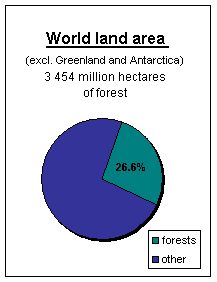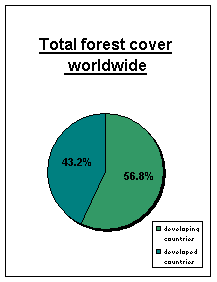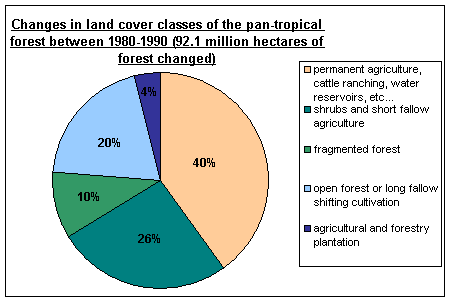| United Nations System-Wide Earthwatch |
|||||||||||||||||
|
FOR AGENDA 21 CHAPTER 11 FORESTS Forest loss - updated 26 July 2000 Forests actively contribute to the world’s environmental stability and are used as economic resources to produce subsistence and industrial forest products. In addition, they have cultural and recreational value. They perform multiple roles, such as preventing soil degradation and erosion, protecting watersheds or stabilizing mountainous areas. They limit the greenhouse effect contributing to global warming, by absorbing CO2 (the main greenhouse gas). Inversely, forest degradation increases CO2 emissions. According to some experts, forests serve as natural habitats to almost two thirds of all Earth’s species, therefore acting as a stronghold to safeguard biodiversity. On an economic level, forests may be used as a direct source of energy or raw materials. Finally, forests play a cultural role in almost all societies, as mythical sceneries or historical backgrounds and as living habitats for about 60 million people worldwide (indigenous and non-indigenous) (GFW).
Despite the importance of forests, reports continue to indicate huge forests losses (FAO, 1997). Almost half of the planet’s original forest has been destroyed, mostly during the last three decades (WRI/WCMC/WWF, 1997). Between 1990 and 1995, the net forest loss equaled 33 football fields per minute (112 600 square kilometers annually) (FAO, 1999, reported by GFW). There are reports from many countries of unsustainable forestry practices (ADB, 1995; Dourojeanni, 1994; Bose, 1995; National Institute for Space Research, 1995; Cushman, 1996; The Economist, 3 February 1996). The majority of the remaining forests are small, disturbed and unable to sustain themselves. However, 40% of the total forest area today can still be found as large, relatively intact and undisturbed natural forests, referred to as frontier forests (WRI/WCMC/WWF, 1997). These play an essential role in maintaining biodiversity, especially protecting indigenous species, as well as in fighting the greenhouse effect. Unfortunately, these areas are under increasing threat as a consequence of growing economies, increasing consumption, and populations with demands for new land. In addition, they suffer from bad economic policies (governments encouraging logging rather than ecotourism, for instance), shortsighted political decisions (such as providing immediate jobs), poverty, corruption and illegal trade. Some specialists encourage governments to stop further frontier forests destruction immediately, to improve management of protected areas and to monitor forest quality (WRI/WCMC/WWF, 1997). Proper forest management "provides an opportunity to reduce greenhouse gas emissions into the atmosphere by avoiding deforestation, and to increase carbon uptake from the atmosphere into the terrestrial biosphere through afforestation, reforestation and improved forest, cropland and range-land management activities" (Watson et al., 2000).
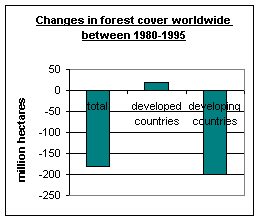 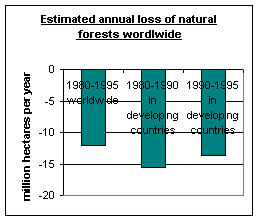
Data from FAO, 1997
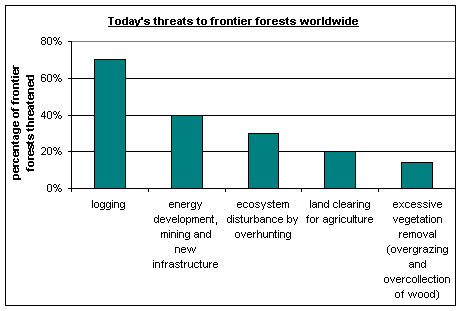 Data from WRI/WCMC/WWF, 1997 Although the total forest area is slowly increasing in developed countries, forest quality is deteriorating, especially in Europe where forests suffer from a combination of air pollution, extreme weather, drought and infestations. In Central and Eastern Europe, 100 000 hectares of forests were lost in the last 20 years from forest damage (FAO, 1997). Canada has overestimated timber growth by about 40% in some provinces, leading to the desperate situation of harvesting rates approaching twice the replanting rates (Nilsson, 1999). In developing countries, forests suffer mainly from overharvesting of fuelwood and overgrazing, although fires, pests and diseases are also critical factors of forest degradation (WRI/WCMC/WWF, 1997). Conservationists in Southeast Asia have been advised to concentrate on protecting forest areas not yet under deforestation pressure, instead of working to protect hotspot areas, where pressures are too great to be resisted (Pearce, 1998). The island of Sumatra (Indonesia) is the worst deforestation hotspot. Although this island is about the size of England, 25 years have been sufficient to destroy all lowland forests with their native faunas. 60,257 square km of Brazilian forest, an area about twice the size of Belgium, was destroyed only between 1995-1997 (INPE, 1998). In 1997, the World Wide Fund for Nature singled out Brazil as the nation with the biggest annual rate of forest loss (WWF, 1997).
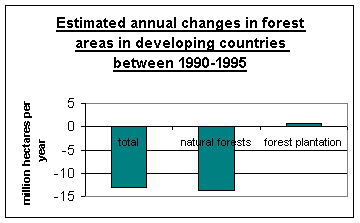 Data from FAO, 1997 Tropical forests, primarily located in
developing countries, are disappearing at the rate of about 21 to 50
football fields per minute (70 000 to 170 000 square kilometer annually)
(GFW). Their destruction correlates
with the recent economic and population growth undergone by developing
countries. Growing needs for space and resources pressure natural forests
into being exploited. But the impact of their gradual disappearance
may be far more dramatic than for boreal and temperate forests, principally
located in developed countries. Indeed, boreal and temperate forests
have regenerated since the last glacial period. They are therefore not
only adapted to rapidly regenerate between glaciation eras, but they
also contain less biodiversity than tropical forests. In contrast, tropical
forests may be far slower in regenerating and their loss would mean
the loss of far more plant and animal species. This underlies the present
political debate where developed countries have tried to prevent developing
countries from exploiting their forest resources, despite the need of
poor local populations to survive. Such conflict can only be resolved
through the implementation of forest management programmes on a planetary
scale, allowing some developing countries to safeguard their natural
forests through some system of global trade management and compensation.
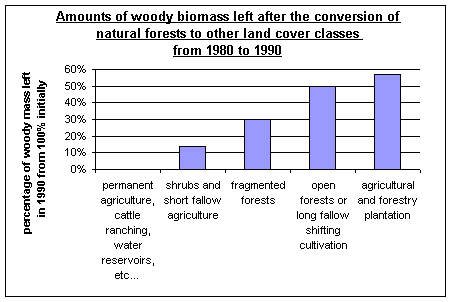 Data from FAO, 1997 On the positive side, the total forest plantation area is increasing worldwide (FAO, 1997). These plantations consist of one or a few species, chosen for their fast growth, yield of commercial products and ease of management. Forest plantations have almost doubled between 1980 and 1995, in both developed and developing countries, to reach the size of 160-180 million hectares in 1995. Most developing countries have planned to double such areas between 1995 and 2010. This expansion is expected to be associated with quality changes in forest management programs, tree breeding and tree improvement, resulting in productivity gains (FAO, 1999). Plantation forests may potentially reduce levels of logging in natural forests, but they also threaten to replace them. The regularly spaced trees of the same age and species in plantation forests offer less resistance to environmental threats, as seen in the damage caused in France by the storms of December 1999. Planting mixed tree species may offer a solution to this problem. Tree diversification decreases the risks of disease and pest outbreaks and fire damage. It improves soil nutrient cycling, increases habitat diversity for native plant and animal species as well as increasing market security (FAO, 1999). Economic and population growth, as well as increasing requirements of land for plantation forests, are generating growing pressures on natural forests. The encouragement of small-scale outgrowers (FAO, 1999), along with better exploitation of the urban and agricultural landscape (planting trees along roads, between fields, etc.), may provide an interesting solution to the problem of space for forest production. Increased involvement of people in forests through community-based management programs has in many cases proven to benefit the environment (soil erosion, water supply and biological diversity), while allowing local populations access to forest resources. "There is a clear link between degraded forests and poverty. We estimated that one billion of the world's poorest people in about 30 heavily deforested countries would be alleviated from poverty if given government support for managing neighboring public forest land and sharing the benefits within their communities" (Salim, 1999). In some parts of Africa, increasing populations have actually increased their tree cover and fuel-wood supplies through planted farm forests and mixing trees, food crops and domestic animals (Holmgren, Peter, et al., 1994). Forest fires - updated to 14 February 1999 Major environmental emergencies caused by wildfires continue to hit the headlines. Dry weather in Indonesia in August 1999 caused a resurgence of fires and threatened a new smog disaster. Different regions of the world have been affected by major forest fires linked to climate variability such as the 1997-1998 El Niño. In 1998, areas affected included Indonesia, parts of Latin America, Florida, Spain, Greece, Russia and elsewhere. UNEP and its partners have published a useful report on Wildland Fires and the Environment: a Global Synthesis (UNEP, 1999). The report summarizes for decision-makers the environmental and health risks from fires and the techniques available to monitor and hopefully reduce the impacts of fires in the future. The Global Fire Monitoring Centre provides access to near-real-time reports on the status of forest and wildfires around the world,as well as international forest fire news, at http://www.uni-freiburg.de/fireglobe/ One example of major forest loss was the problem of forest fires in Indonesia, especially on the islands of Borneo and Sumatra, during 1997-1998. The fires produced a choking haze which blanketed a large area of South East Asia, causing widespread health and environmental problems. In Kalimantan, on the Indonesian part of Borneo, after severe fire loses in 1997, fires raged from January to May 1998, when the rains returned. At one point, 808 fire sites were identified by satellite pictures. The area of forest destroyed in Kalimantan and Sumatra alone in 1997-1998 has been estimated as 456,000 hectares (45,600 square kilometres) (UNEP, 1999). The fires in the region in 1997 produced carbon dioxide emissions equal to the overall emissions of carbon dioxide from Europe for a year. Almost all of Kutai National Park, the Wein River orang-utan sanctuary, and unique limestone forests in the north of Kalimantan were destroyed by fire. Kalimantan contains 14 percent of global biodiversity potential. According to WCMC, the fires in Indonesia threatened at least 19 protected areas, all internationally important, including a World Heritage site (Ujung Kulon in Java), Ramsar Wetland (Berbak in Sumatra) and Biosphere Reserve (Tanjung Puting in Kalimantan). The fauna of Indonesia is considered at particular risk from fire as the country is home to more than 100 threatened animal species including the highest number of threatened mammals and the second highest number of threatened birds of any country in the world. The region is also notable for the wide variety of its plant life and 500 tree species were considered under threat of extinction even before the current fire tragedy. Unique forest ecosystems such as heath forest and peat-swamp forest are particularly vulnerable to fire, which destroys their fragile soils. Many of the fires in Indonesia were started for the purposes of shifting cultivation or conversion of forest to palm oil production. The November 1997 report of the United Nations Disaster Assessment and Coordination Team (of which UNEP was a member) concluded that the fires "have turned out to be an environmental emergency of exceptional proportions", and warned of "a repetition of the present emergency" if current practices remained unchanged. Forest fires were also major problem in 1998 in Brazil, where, by the end of March, fires had rapidly spread deep into the rainforest and over a million hectares of savannah woodland had burnt. Mexico suffered its worst drought in 70 years, allowing smoldering fires to burn about 3,000 square kilometres of land, and sending smoke across the southern United States. The Chimalpas forest with many rare species was particularly threatened by fires burning out of control. Mr. Klaus Töpfer, Executive Director of the United Nations Environment Programme (UNEP), referred to the fires as possibly "the greatest ecological disaster of the decade." "The tragedy is that future generations, who have no say in current policy, will have to bear the costs, and nobody seems willing to safeguard their interests," he said. The UN Secretary-General named Mr. Töpfer to coordinate the response of the United Nations system to these environmental catastrophes. (Other sources: UNEP Information Note 1997/31 of 28 October 1997, updated with UNEP News Releases of 19 February 1998, and 27 and 28 April 1998, news reports of 3 April and 21 May 1998, and IFFM, 1998) |
|||||||||||||||||
| REFERENCES AND SOURCES | |||||||||||||||||
|
ADB. 1995. Asian Development Bank report on forest policy, cited in "Asian forest destruction targeted by aid bank." Reuter, 6 March 1995. Bose, Kunal. 1995. "The shrinking forests of India". Financial Times, 6 September 1995. Cushman, John H., Jr. 1996. "Siberian logging sets off U.S. battle". New York Times, 30 January 1996. Dourojeanni, Marc. 1994. (Inter-American Development Bank) Quoted in "Official says forest destruction alarming". Reuter, 2 May 1994. The Economist, 1996b. "Forest fire", 3 February 1996. FAO. 1997. State of the World’s Forests, 1997. Food and Agriculture Organization of the United Nations, Rome, 1997. http://www.fao.org/forestry FAO. 1999. State of the World’s Forests, 1999. Third edition. Food and Agriculture Organization of the United Nations, Rome, 1999. http://www.fao.org/forestry/FO/SOFO/SOFO99/sofo99-e.stm Global
Forest Watch. www.globalforestwatch.org.
Holmgren, Peter, et al. 1994. Ambio 23(7). Cited in Pearce, Fred. "Trees are on the march?" New Scientist, 24/31 December 1994, p. 17. IFFM. 1998. Integrated Forest Fire Management (IFFM) project report, quoted in Fred Pearce "Burnt out", New Scientist, 25 July 1998, p. 13. INPE. 1998. Brazil's National Space Research Institute (INPE). Reported by J. Craig . "Ravaging of Brazil's Amazon continues - survey". REUTERS, 26 January 1998 (see also http://www.inpe.br). National Institute for Space Research (Brazil). 1995. Quoted in Schemo, Diana Jean. "Amazon is burning again, as furiously as ever". New York Times, 12 October 1995. Nilsson, S., Colberg, R., Hagler, R., Woodbridge, P. (1999). How Sustainable Are North American Wood Supplies? The International Institute for Applied Systems Analysis, Austria. http://www.iiasa.ac.at/Research/FOR/papers/naws/index.htm Pearce, F. 1998. Beyond hope. New Scientist, 1998 Oct. 31. Pearce, F. 1999. Chainsaw massacre. New Scientist, 1999 Feb. 6. Salim, E. 1999. (co-chairman of the Commission and former Indonesian Minister of Population and Environment). World Commission on Forests and Sustainable Development (1999). http://iisd1.iisd.ca/wcfsd/default.htm. TREES. 1998. Tropical Ecosystem Environment Observation by Satellite (TREES) project. Oct. 1998. UNEP. 1999. J.S. Levine, T. Bobbe, N. Ray, A. Singh and R.G. Witt. Wildland Fires and the Environment: a Global Synthesis. Environmental Information and Assessment Technical Report UNEP/DEIA&EW/TR.99-1. United Nations Environment Programme, Nairobi, Kenya. Available from Dr. Ashbindu Singh, Regional Coordinator, DEIA&EW North America, EROS Data Center, Sioux Falls, SD 57198, USA, E-mail: singh@edcmail.cr.usgs.gov Watson, R.T., Noble, I.R., Bolin, B., Ranindranath, N.H., Verardo, D.J., Dokken, D.J. 2000. Land use, land-use change and forestry. Special Report of the Intergovernmental Panel on Climate Change. Cambridge University Press, UK. http://www.ipcc.ch/pub/reports.htm. WRI/WCMC/WWF. 1997. Bryant, D., Nielson, D., Tangley, L. (1997). The last frontier forests: ecosystems and economies on the edge.World Resources Institute, Forest Frontiers Initiative, in cooperation with the World Conservation Monitoring Center and the World Wide Fund for Nature. http://www.wri.org/wri WWF.
1997. "Two-Thirds of The World's Forests Lost Forever". Press
Release 8 October 1997. Forests for Life Campaign web site. http://www.panda.org/forests4life/news/081097_lostfor.cfm
Maps/Links World Conservation Monitoring Center. http://www.wcmc.org.uk/forest/data/cdrom2/stat1.htm World Resources Institute: Forest Frontier Initiative. http://www.igc.org/wri/ffi/maps/ |
|||||||||||||||||

